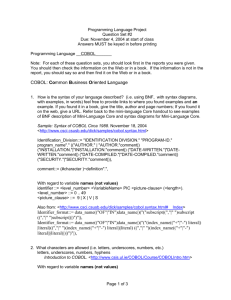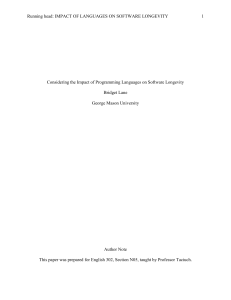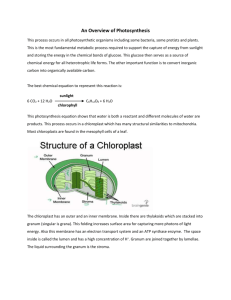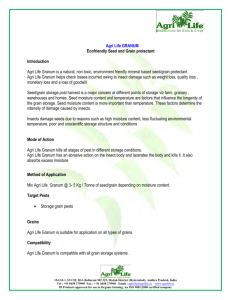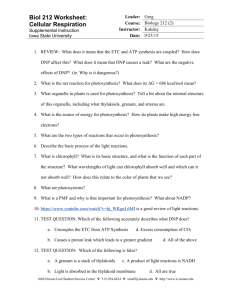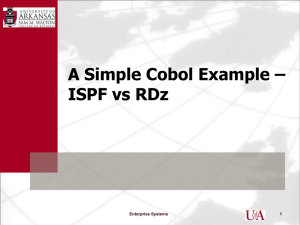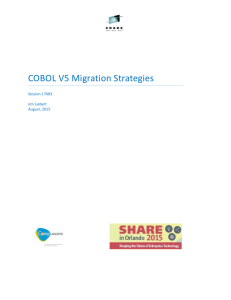cobol reengineering - IT
advertisement
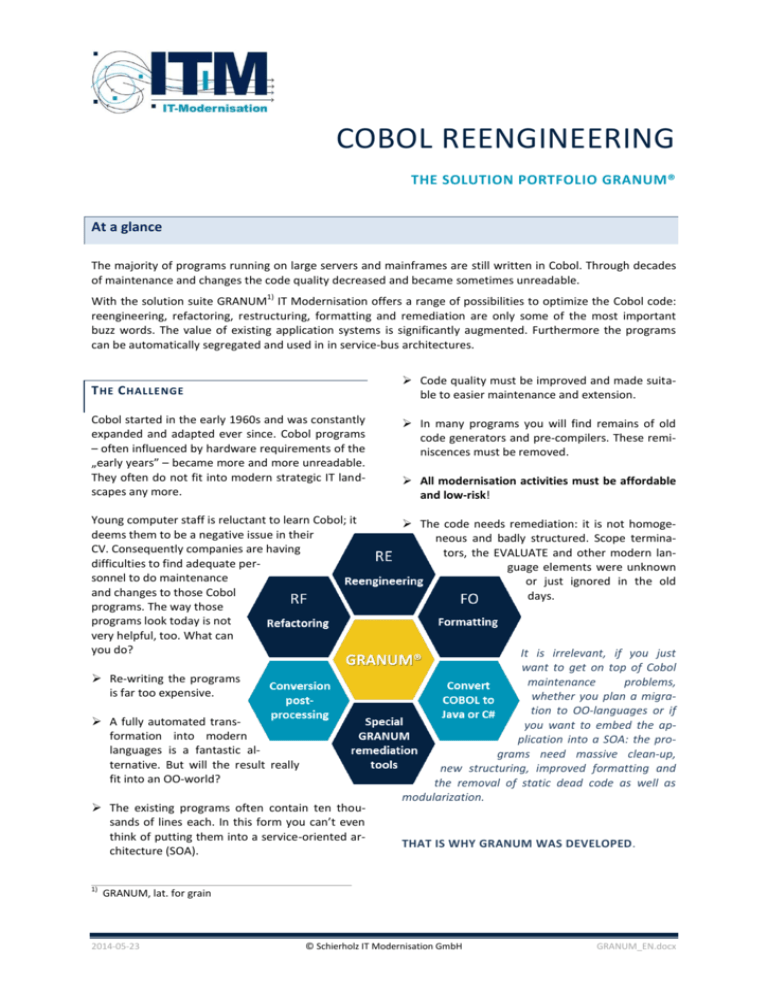
COBOL REENGINEERING THE SOLUTION PORTFOLIO GRANUM® At a glance The majority of programs running on large servers and mainframes are still written in Cobol. Through decades of maintenance and changes the code quality decreased and became sometimes unreadable. 1) With the solution suite GRANUM IT Modernisation offers a range of possibilities to optimize the Cobol code: reengineering, refactoring, restructuring, formatting and remediation are only some of the most important buzz words. The value of existing application systems is significantly augmented. Furthermore the programs can be automatically segregated and used in in service-bus architectures. Code quality must be improved and made suitable to easier maintenance and extension. T HE C HALLENGE Cobol started in the early 1960s and was constantly expanded and adapted ever since. Cobol programs – often influenced by hardware requirements of the „early years” – became more and more unreadable. They often do not fit into modern strategic IT landscapes any more. In many programs you will find remains of old code generators and pre-compilers. These reminiscences must be removed. Young computer staff is reluctant to learn Cobol; it deems them to be a negative issue in their CV. Consequently companies are having difficulties to find adequate personnel to do maintenance and changes to those Cobol programs. The way those programs look today is not very helpful, too. What can you do? The code needs remediation: it is not homogeneous and badly structured. Scope terminators, the EVALUATE and other modern language elements were unknown or just ignored in the old days. Re-writing the programs is far too expensive. A fully automated transformation into modern languages is a fantastic alternative. But will the result really fit into an OO-world? The existing programs often contain ten thousands of lines each. In this form you can’t even think of putting them into a service-oriented architecture (SOA). 1) All modernisation activities must be affordable and low-risk! It is irrelevant, if you just want to get on top of Cobol maintenance problems, whether you plan a migration to OO-languages or if you want to embed the application into a SOA: the programs need massive clean-up, new structuring, improved formatting and the removal of static dead code as well as modularization. THAT IS WHY GRANUM WAS DEVELOPED. GRANUM, lat. for grain 2014-05-23 © Schierholz IT Modernisation GmbH GRANUM_EN.docx COBOL RE-ENGINEERING remove periods without semantic meaning GRANUM Components introduce scope terminators Like all other products of IT Modernisation, GRANUM is implemented as a collection of Rules and Rule Sets. These rules are written in IT-M’s proprietary language SPL (Sourcecode Processing Language) which is part of the RULAMAN®framework. replace unprintable (hidden) characters by literals und VALUE clauses introduce figurative constants in lieu of literals or VALUE definitions transform intrinsic functions of different manufacturers RE – R EENGINEERING RF – R EFACTORING Her are the GRANUM.RE: most important functions of REMEDIATION. GRANUM.RE transforms language constructs, which are no longer supported or which will produce error messages in new Cobol compilers into legal Cobol statements. REENGINEERING. GRANUM.RE re-structures the code, removes branch instructions, introduces scope terminators (END-clauses) and uses a set of smart algorithms to produce a program, which is well readable and which may as well be positioned for a transformation into an objectoriented language like Java or C#. DIALECT ADAPTATION. There are more than 300 different, mostly incompatible Cobol dialects: versions and variations are shaped by operating system and hardware architecture or just – by the marketing department. In the course of migration from Cobol-68 to Cobol74 many statements or clauses were changed or replaced by new constructs. The old formats are mutually still supported by many compilers although they are not described in the language reference manual any more. GRANUM.RE can convert any Cobol dialect into any other or move it to a “standard” Cobol. Find here some more functions, some of them selectable as options: resolve so-called ”spaghetti-code” remove many or all of the GO TO instructions structuring into sections and paragraphs detect and dislocate subroutines transform IF-sequences and IF-cascades into EVALUATE Structures GRANUM.RF segregates large Cobol programs into individually shaped small modules. To achieve this, the developer places appropriate marks at paragraph or section boundaries. GRANUM.RF will then perform the following: The marked parts are carved out of the primary program and transformed into complete and fully functional Cobol modules („here: secondary programs“). Data fields of the primary program being referenced by the secondary program are passed via new definitions in the LINKAGE SECTION. The values of these fields are collected in the primary program prior to calling the secondary program. On return from the secondary program the fields of the primary program are loaded with the new values. The coding to connect primary and secondary program is contained natively in the programs: there are no runtime routines! Branch instructions which point from the secondary into the primary program are supported by code which generated into both programs. NB: Too many of such branch instructions can make the program logic difficult to comprehend. Consider using GRANUM.RE prior to GRANUM.RF to reduce or eliminate branch instructions. The secondary program is “lean” i.e., it takes over only those definitions which are really necessary. If e.g. data structures are needed because of REDEFINES, all unreferenced fields are collated into single FILLER fields. remove static dead procedural code eliminate unused fields 2014-05-23 © Schierholz IT Modernisation GmbH GRANUM_EN.docx COBOL RE-ENGINEERING The developer will have to supply the following: 1. Start and end of the future secondary program 2. The desired name (PROGRAM-ID) of the secondary program 3. Optionally a description of the new program as Cobol comment 4. Name of the developer The new primary and secondary programs are immediately functioning. As a whole together with the primary program they will perform the functionality of the former monolithic program. When applying the appropriate granularity such modules are perfectly suited to be used as services in an ESB (Enterprise Service Bus). Define decision tables in some short hand notation Produce code using macros Those products are often still in production because you cannot transform the related code sequences error-free and without risk into native Cobol. Another issue is the maintenance of programs which were generated by 4GL-compilers like CSP or PACBASE. The programs had to be maintained on the basis of the generated code because the original 4GL language compiler was no longer available. All of these subjects are addressed by special GRANUM remediation tools included in the GRANUM-Suite. In actual customer situations we developed the following special GRANIUM products: FO – F ORMATTING Elimination of SWT01 (program generator) In the old days programming standards were sometimes not known or they existed only rudimentary. When such standards were introduced at a later stage there was no time to overhaul the existing code. Elimination of VORELLE (decision table) Furthermore every programmer had his own ideas of indentation and formal structuring. We are constantly increasing the number of tools. With GRANUM.FO you can define Cobol standards easily and re-format existing programs fully automated. Of course this will not influence program function in any way. The programs gain a lot of readability and maintainability. Extract Cobol data structures from programs and transform them to data base definitions Ask us: based on the existing GRANUM components, RULAMAN.SPL allows creating new Remediation Tools with relatively small effort. M ORE GRANUM APPLICATIONS We want to emphasize two other interesting possibilities: GRANUM R EMEDIATION T OOLS In the past decades many products were used within Cobol to Increase developer productivity Produce uniform code structures Solve standard problems of processing such as group control, intermediate sums, sorting, printout of listings etc. Produce documentation directly from the source code (passive documentation systems) Document maintenance activities Place change management information right in the source code 2014-05-23 Remediation of PACBASE Cobol 1. Consider assembler programs which were transformed by the IT-M product A2C and successfully tested. Especially large programs can be processed further by GRANUM to increase their value. After refactoring with GRANUM/RF logic modules within the former assembler program may now be segregated into separate service routines (this is the so-called SOA-fication). 2. Preceding a fully automated or semi-manual conversion from Cobol to Java or C# the code must be transformed along certain rules. Otherwise the migration to Java or C# will produce code which you would never want to go in production. When developing GRANUM we have taken such possibilities into account. © Schierholz IT Modernisation GmbH GRANUM_EN.docx COBOL RE-ENGINEERING The advantages of modernisation with GRANUM® Related to the above challenges, resulting from the huge number of Cobol programs and – more important – from the value of the business logic contained therein, GRANUM offers a number of elegant answers. Remediated Cobol code, which is well readable and clearly structured, which has no leftovers form old technologies or habits of the past century will also be understood by young computer staff. They will have less problems maintaining and extending it. This may help solving the personnel problem for application development of classic IT shops. The automated transformation from Cobol to an OO-language is possible, if the code was positioned accordingly. Programs which were processed in this way are much easier to be maintained and run without pain within a clean OO-environment. Note: We suggest a pragmatic approach when talking about the migration from Cobol to OO: you should first verify which programs are suitable for such a migration at all: it does not make sense to transform millions of code lines from Cobol to Java or C# without further examination. Some programs make more sense in Cobol; others are well suited for the migration. Existing Cobol monoliths are chopped automatically into small modules. These modules can then be used as external subprograms or as services within a service-oriented architecture. Code which was remediated and improved in many ways is easier to maintain; debugging and even program changes or extensions will be “cheaper” to obtain. The dependency from antique third-party products like pre-compilers, code generators, macro systems, decision table generators etc. is fully removed. As some of these products are still subject to licensing contracts there is an interesting potential for saving. Even more important is to get rid of the risk which arises from products which went out of service long time ago or where the originating company disappeared from the market. The risk of transformation is minimal, because human errors and fatigue are non-existing. A code freeze is not necessary, because the RULAMAN technology can convert millions of lines within hours. The cost of transformation with GRANUM is only a fraction of a manual or semi-automated process. You want to exploit the possibilities of GRANUM®? We are offering GRANUM as a service with fixed price. This means we will process your COBOL code in total or in packages. We will agree on the precise parameters of the transformation with you in advance. Please contact us regarding your reengineering requirements and needs. Schierholz IT Modernisation GmbH Übersee-Haus Baumwall 5 20459 Hamburg +49 40 8398 4130 www.it-modernisation.com 2014-05-23 © Schierholz IT Modernisation GmbH GRANUM_EN.docx

